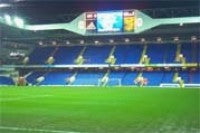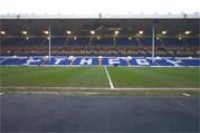Clear effect of Shade
Clear effect of shade
By Paul Knowles

The experience I have had so far at Tottenham is completely different to my time at Rushden & Diamonds. There, we had more training and games, but the micro climate at a big stadium such as White hart Lane is a challenging scenario, and I have already learned a great deal in my time here.
It is already clear to me that we are losing grass at the stadium even without the wear and tear of matches due to the shade and lack of air movement. I have to look at all maintenance procedures very closely to minimise any damage to the pitch.
We've had to contain four outbreaks of fusarium on the pitch this summer, with the last outbreak on the morning of the first match against Leeds. There were dozens of small patches on the pitch, showing up in the early morning dew. That put paid to Sunday's day of rest, with both Darren and myself coming in to divot and mow the pitch, prior to an application of Rovral Green. It appeared to check the disease almost immediately and by the end of the following week the grass had recovered.
This outbreak just compounded a nerve wracking summer, with high temperatures and no rain, we've had to use our irrigation almost constantly which hasn't been conducive to improving root growth. Even when we decided to leave the irrigation off to try and dry the upper root zone, the heat was so intense that large brown patches of wilted grass would appear in an afternoon, forcing us to syringe the pitch during the daytime hours just to keep the surface cooler.
The stadium just encourages heat retention and on the hottest recorded day of the year (at Gravesend it was 37 degrees celsius), we recorded temperatures on the pitch ten degrees higher!
This summer has been so different. Under normal circumstances I'd like to give the pitch a heavy soaking and then leave it for two or three days so the roots can chase the water down the profile. This simply hasn't been possible this year and although I am not unduly worried at this stage there are a few signs that the pitch isn't quite right yet.
The roots have not been as deep as I'd like, although in recent weeks they have improved. At the North end they are down to about 150mm but at the South end they are barely 75mm, with the south west corner showing root growth at no more than 25mm. As the sun starts to creep lower in the sky the permanent shade is moving up the pitch, so the south end of the ground will now not see any more direct sunlight until next summer. The permanent shade line in a couple more weeks will be on the half way line, with the north end only seeing direct sunlight for perhaps no more than three hours a day.
Another problem is the amount of surface algae already present on the pitch at the south end. I am trialling a Rigby Taylor product called 'Profile', which we're using on the areas of algae. This product is supposed to reduce the surface algae and provide more traction, therefore less slippery for the players. I believe that Terry used it last season at Anfield and had some good results. 
I have been aerating the south end with both the vertidrain and the Procore machines, and I am also looking to purchase a light shallow hand spiker that will just prick the surface down to 5-10mm to allow water and air to get into the root zone, without disturbing the surface prior to matches.
The pitch has been very soft for the start to the season and we can only put this down to the weather. After the first match there were a lot of heel marks, something that wasn't encountered last season. If there wasn't the Desso re-inforcement in the pitch then we could have more problems than we've already got.
Since that first game we've tried to be more lenient with the watering prior to the match, as the ground has been so dry and there's been precious little in the way of rainfall. We've come to the conclusion that keeping all the profile at a consistent moisture level is impossible at the moment and instead opted to keep it all dry instead. Certainly our last game against Everton, where we opted for drier conditions, the pitch played much better.
Watering the pitch in a uniform manner isn't that easy anyway, with the shade problems and the algae. Less water is required on these areas. Even with an automatic irrigation system, we have ended up hand watering to avoid over saturating the shaded areas.
I have started to brush the pitch using a 1.5 metre hand brush. This helps to remove debris from the surface and leave it on top of the sward to be collected by the Honda rotary mowers when we cut the pitch. By using the rotaries I hope to be able to retain more grass at the south end of the pitch. At the start of October we raised the height of cut to 28mm, and we are cutting the pitch about three times a week at the moment. I leave the grass in both goalmouths slightly longer at 35mm, and also miss out mowing the last few bands at the south end of the pitch during one of the mowing operations each week. This helps to relieve plant stress caused by over mowing in the shaded areas.
This height of cut for the pitch allows a little extra protection but, come next March, the height will be reduced back down to 23mm for the last six weeks of the season.
The goalmouths have held up very well so far, just the south goal showing some signs of thinning. Starting next week though we have three games in seven days, so I'd expect to see some more wear by the following weekend.
We verti-drained the whole pitch last week, which will help to soften the pitch up again, but as we move through October, we find ourselves caught between a rock and a hard place. The reality is that when it starts to rain, it will no doubt be torrential and we need to make sure with three games in succession that excess rainfall will be able to travel through the pitch quickly without puddling on top.
There is clear definition on the pitch between the areas that have sunshine and those that don't. The north end is a sward full of healthy thick grass, but as you walk down the pitch towards the south end the grass starts to thin, even to the point where the spring seed lines are clearly visible. The temperature drops noticeably as well from north to south.
My aim is to keep a good head of grass on the pitch between now and December, This is the time that I think the most damage is done, I say this because there are a lot of games booked in during the autumn whereas the months of December and January tend to include fewer fixtures.
To finish this article, I am fully behind trying to improve the situation with regards to excessive pre-match warm ups. A set rule with time limits would certainly be a step in the right direction. The pitch is there to be used for matches and sensible warm ups, but the damage caused by the warm ups can affect the ball rolling properly during the game. Hopefully, with better communication between all parties involved we will come up with a reasonable compromise in the future.
